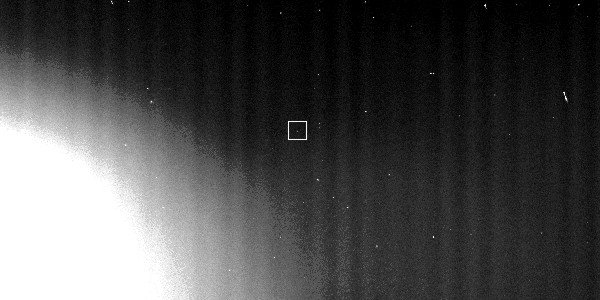Pallene (moon) on:
[Wikipedia]
[Google]
[Amazon]
Pallene is a very small
 Pallene was discovered by the Cassini Imaging Team in 2004, during the
Pallene was discovered by the Cassini Imaging Team in 2004, during the
 In 2006, images taken in forward-scattered light by the ''Cassini'' spacecraft enabled the Cassini Imaging Team to discover a faint dust ring around Saturn that shares Pallene's orbit, now named the Pallene Ring. The ring has a radial extent of about 2,500 km. Its source is particles blasted off Pallene's surface by meteoroid impacts, which then form a diffuse ring around its orbital path.
In 2006, images taken in forward-scattered light by the ''Cassini'' spacecraft enabled the Cassini Imaging Team to discover a faint dust ring around Saturn that shares Pallene's orbit, now named the Pallene Ring. The ring has a radial extent of about 2,500 km. Its source is particles blasted off Pallene's surface by meteoroid impacts, which then form a diffuse ring around its orbital path.
 The ''Cassini'' spacecraft, which studied Saturn and its moons until September, 2017, performed a fly-by of Pallene on 16 October 2010, and 14 September 2011 at a distance of 36,000 kilometers (22,000 miles) and 44,000 kilometers respectively.
The ''Cassini'' spacecraft, which studied Saturn and its moons until September, 2017, performed a fly-by of Pallene on 16 October 2010, and 14 September 2011 at a distance of 36,000 kilometers (22,000 miles) and 44,000 kilometers respectively.
Pallene Profile
b
NASA's Solar System Exploration
{{DEFAULTSORT:Pallene (Moon) Moons of Saturn 20040601 Moons with a prograde orbit
natural satellite
A natural satellite is, in the most common usage, an astronomical body that orbits a planet, dwarf planet, or small Solar System body (or sometimes another natural satellite). Natural satellites are often colloquially referred to as ''moons'' ...
of Saturn
Saturn is the sixth planet from the Sun and the second-largest in the Solar System, after Jupiter. It is a gas giant with an average radius of about nine and a half times that of Earth. It has only one-eighth the average density of Earth; h ...
. It is one of three small moons known as the Alkyonides that lie between the orbits of the larger Mimas and Enceladus
Enceladus is the sixth-largest moon of Saturn (19th largest in the Solar System). It is about in diameter, about a tenth of that of Saturn's largest moon, Titan. Enceladus is mostly covered by fresh, clean ice, making it one of the most refle ...
. It is also designated .
Discovery
 Pallene was discovered by the Cassini Imaging Team in 2004, during the
Pallene was discovered by the Cassini Imaging Team in 2004, during the Cassini–Huygens
''Cassini–Huygens'' ( ), commonly called ''Cassini'', was a space-research mission by NASA, the European Space Agency (ESA), and the Italian Space Agency (ASI) to send a space probe to study the planet Saturn and its system, including its r ...
mission. It was given the temporary designation . In 2005, the name Pallene was provisionally approved by the IAU Division III Working Group for Planetary System Nomenclature, and was ratified at the IAU General Assembly in 2006. The name refers to Pallene, one of the Alkyonides, the seven beautiful daughters of the giant
In folklore, giants (from Ancient Greek: ''gigas'', cognate giga-) are beings of human-like appearance, but are at times prodigious in size and strength or bear an otherwise notable appearance. The word ''giant'' is first attested in 1297 fr ...
Alkyoneus.
After the discovery in 2004, it was realized that Pallene had been first photographed on August 23, 1981, by the space probe '. It had appeared in a single photograph and had been provisionally named and estimated to orbit 200,000 km from Saturn. Because it had not been visible in other images, it had not been possible to compute its orbit at the time, but recent comparisons have shown it to match Pallene's orbit.
Orbital characteristics
Pallene is visibly affected by a perturbing mean-longitude resonance with the much larger Enceladus, although this effect is not as large as Mimas's perturbations on Methone. The perturbations cause Pallene'sosculating orbit
In astronomy, and in particular in astrodynamics, the osculating orbit of an object in space at a given moment in time is the gravitational Kepler orbit (i.e. an elliptic or other conic one) that it would have around its central body if pertu ...
al elements to vary with an amplitude of about 4 km in semi-major axis, and 0.02° in longitude (corresponding to about 75 km). Eccentricity also changes on various timescales between 0.002 and 0.006, and inclination between about 0.178° and 0.184°.
Ring
Exploration
 The ''Cassini'' spacecraft, which studied Saturn and its moons until September, 2017, performed a fly-by of Pallene on 16 October 2010, and 14 September 2011 at a distance of 36,000 kilometers (22,000 miles) and 44,000 kilometers respectively.
The ''Cassini'' spacecraft, which studied Saturn and its moons until September, 2017, performed a fly-by of Pallene on 16 October 2010, and 14 September 2011 at a distance of 36,000 kilometers (22,000 miles) and 44,000 kilometers respectively.
References
Further reading
* * * * * * * * * * * *External links
*Pallene Profile
b
NASA's Solar System Exploration
{{DEFAULTSORT:Pallene (Moon) Moons of Saturn 20040601 Moons with a prograde orbit